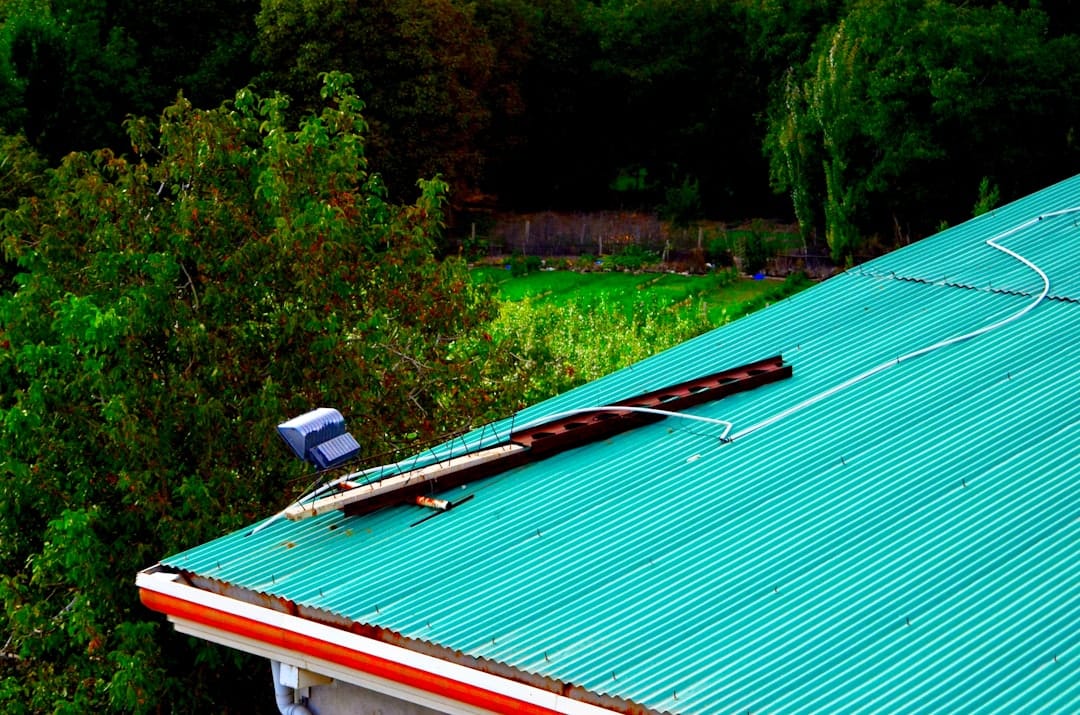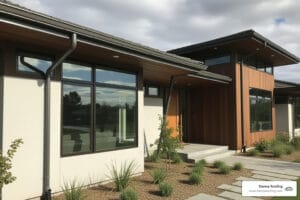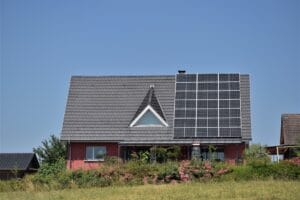Sugar Land Roof Repair: Protecting Your Home from Texas Weather Extremes
For homeowners in Sugar Land and across Fort Bend County, understanding the nuances of roofing repair in Sugar Land is not just about home maintenance; it’s about safeguarding your most significant investment against the relentless Texas weather. Your roof serves as your home’s primary shield, and in a region known for its unpredictable climate, that shield needs to be in peak condition. Our expert roofing services are meticulously designed to address the unique challenges posed by our local environment. Here’s a more detailed look at what you need to know:
-
Most Common Issues: The trifecta of roof problems in Sugar Land includes hail damage, wind-blown shingles, and heat-related wear. Hail, even when small, can create bruises and micro-fractures on shingles that compromise their integrity. High winds, especially during thunderstorms or the outer bands of a hurricane, can lift, curl, or completely remove shingles, leaving your roof’s underlayment exposed. Finally, the intense, prolonged Texas sun bakes roofing materials, causing asphalt shingles to become brittle, crack, and lose their protective granules over time.
-
Average Repair Cost: While a broad average for the greater Houston area is $370-$400 per square (a 10×10 foot area), the actual cost for your Sugar Land roof repair can vary significantly. Factors influencing the price include the type of roofing material (asphalt shingles are generally less expensive to repair than tile or metal), the steepness or pitch of your roof (steeper roofs require more safety equipment and labor), the extent of the damage, and whether the underlying decking is also damaged and needs replacement.
-
When to Repair vs Replace: The age of your roof is the primary factor. Roofs under 15 years old with isolated, contained damage are excellent candidates for repair. For instance, if a single tree limb caused a puncture or a small patch of shingles was lost in a storm, a targeted repair is efficient and cost-effective. However, if your roof is approaching the 20-year mark and exhibits widespread issues like extensive granule loss, brittleness across multiple slopes, or recurrent leaks, a full replacement is often the more prudent long-term investment.
-
Best Materials: In Sugar Land’s climate, material choice is critical. Modern architectural asphalt shingles offer a great balance of durability, cost, and aesthetic appeal. For superior longevity and energy efficiency, standing seam metal roofing is an outstanding choice, reflecting solar heat and withstanding high winds exceptionally well. Tile roofing, whether clay or concrete, provides a classic look with excellent durability and resistance to heat and storms, though it comes at a higher initial cost.
-
Our Professional Process: We believe in a transparent and thorough approach. It begins with a comprehensive Inspection, where we get on your roof to assess every component, from shingles and flashing to vents and decking. Next is the Assessment, where we analyze our findings, document them with photos, and determine the best course of action. We then provide a detailed Quote, explaining the scope of work and all associated costs, with no hidden fees. Once approved, the Repair is scheduled and executed by our skilled technicians using high-quality materials. The final step is a rigorous Quality Check and site cleanup to ensure the repair meets our high standards and your property is left pristine.
Your roof is your home’s first and most important line of defense against Sugar Land’s intense storms, blazing heat, and oppressive humidity. With the average lifespan of roofs in the Houston area hovering between 15-20 years, understanding when and how to address damage is paramount. Making the right call can save you thousands of dollars in the long run and, more importantly, protect your family’s safety and comfort.
From the hurricane-force winds that threaten the Gulf Coast to the sudden, violent hailstorms that can materialize in an afternoon, Sugar Land homes face serious meteorological challenges year-round. The financial breakdown for most roofing projects is approximately 40% for materials and 60% for labor. This highlights the critical importance of selecting a contractor who not only uses quality materials but also employs skilled, experienced technicians to ensure a flawless installation or repair.
I’m Andre Castro, CEO and founder of Sienna Roofing. With over five years of dedicated experience helping Sugar Land homeowners navigate the complexities of roofing repair sugar land challenges, I bring a unique perspective to every project. My background in Construction Management from Texas A&M University, combined with a hands-on, client-focused approach, ensures that every repair we undertake is engineered to meet the highest standards and withstand our community’s demanding climate. We’re not just contractors; we’re your neighbors, committed to protecting our community one roof at a time.
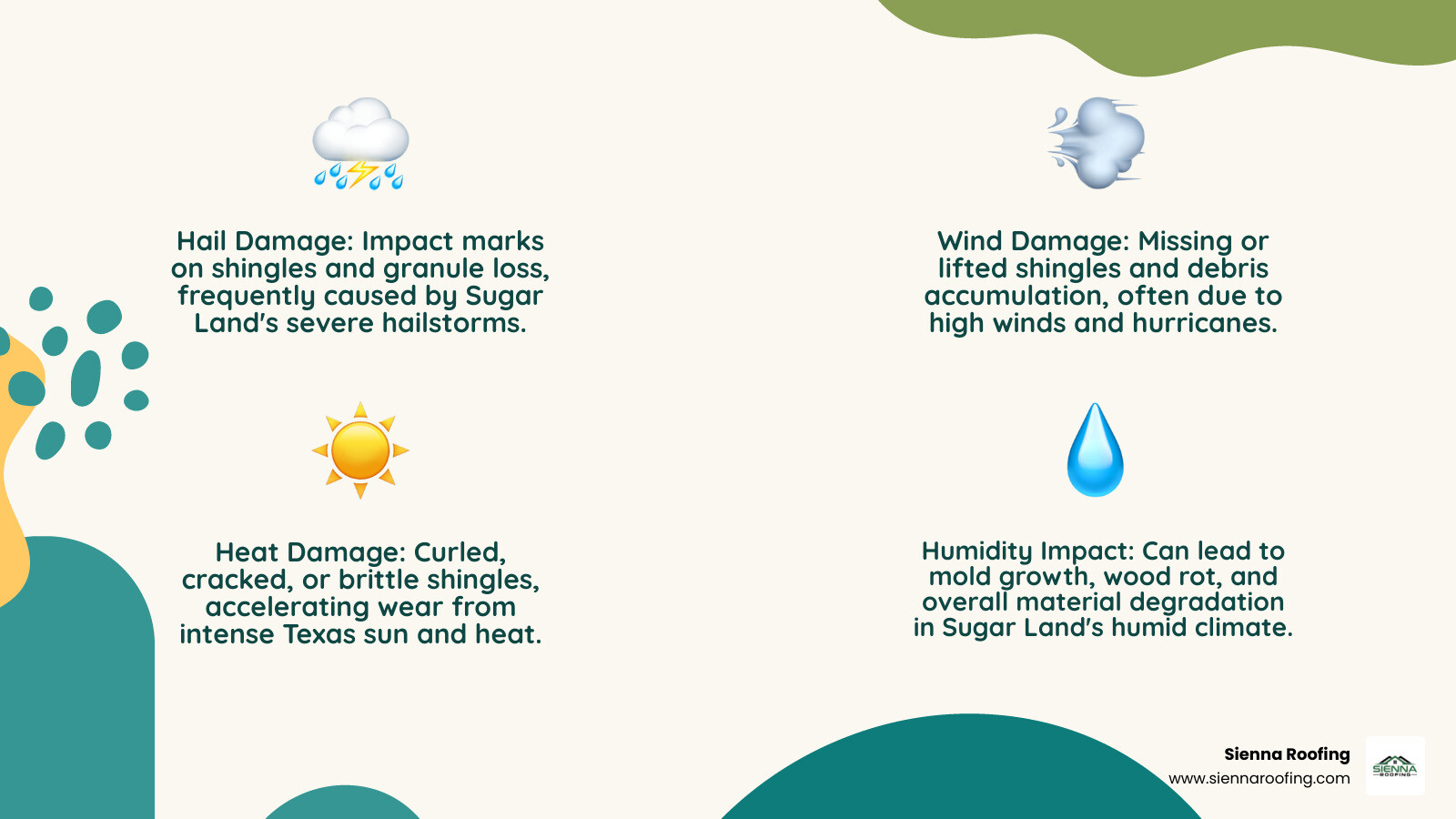
For homeowners in Sugar Land, a sturdy, well-maintained roof is the cornerstone of a safe and secure home. We at Sienna Roofing understand the critical importance of proactive roof care and are dedicated to providing the expertise and service necessary to keep your home protected from the elements.
Your Local Sugar Land Roofing Experts
Sienna Roofing
Address: 17034 University Blvd, Sugar Land, TX 77479
Phone: (832) 564-3322
Decoding Roof Damage in Sugar Land: A Homeowner’s Guide
Sugar Land, strategically located in the heart of Fort Bend County, experiences a unique and often challenging blend of weather patterns that can be particularly harsh on residential roofs. From the sweltering, long summer days to sudden, severe thunderstorms that seem to appear out of nowhere, our roofs are in a constant battle against the elements. Gaining a deep understanding of the specific types of damage your roof might face is the essential first step toward effective and timely roofing repair Sugar Land.
The most prevalent types of roof damage we encounter in Sugar Land, TX, are a direct consequence of our subtropical climate:
- Hurricanes and Tropical Storms: While direct hurricane landfalls in Sugar Land are rare, we frequently experience the powerful outer bands of these systems. These bring torrential rains and sustained high winds that create significant uplift pressure on shingles, leading to lifting, tearing, and water intrusion. The sheer volume of water can overwhelm gutters and find its way into any small vulnerability in the roofing system.
- Hailstorms: Sugar Land is situated in an area prone to severe thunderstorms that can produce damaging hail. Hailstones, ranging from pea-sized pellets to destructive golf ball-sized (or even larger) ice chunks, can wreak havoc. They can puncture roof surfaces, crack shingles and tiles, and create significant dents in metal roofing. This damage, known as “hail bruising” on asphalt shingles, crushes the fiberglass mat and displaces the protective granules, creating a weak spot that will rapidly deteriorate under the sun.
- High Winds: Beyond tropical systems, strong thunderstorms are a regular feature of our weather, bringing wind gusts that can easily exceed 50-60 mph. These winds can rip off shingles, particularly older or improperly installed ones, loosen the metal flashing around chimneys and vents, and turn loose tree branches into projectiles that can puncture your roof.
- Intense Sun and Heat: The relentless Texas sun is one of the biggest long-term enemies of your roof. The combination of high temperatures and direct UV radiation accelerates the aging process of most roofing materials, especially asphalt shingles. This thermal cycling causes them to lose their volatile oils, leading to brittleness, cracking, and curling over time, making them much more susceptible to wind and hail damage.
- Humidity Impact: Our region’s high humidity creates a perfect environment for the growth of algae, moss, and mold, especially on shaded or north-facing roof slopes. This not only causes unsightly black streaks (Gloeocapsa magma algae) but can also trap moisture against the shingle surface, leading to rot and decay. In poorly ventilated attic spaces, humidity can contribute to the deterioration of the roof decking from below.
- Water Damage: Ultimately, most forms of roof damage culminate in water intrusion. Whether it’s from a hail-punctured shingle, wind-lifted flashing, or a cracked pipe boot, water is the ultimate enemy of your home’s interior. It can lead to stained ceilings and walls, damaged insulation, rotted wood framing, and the development of harmful mold within your home, turning a simple roof issue into a major and costly restoration project.
It’s abundantly clear that our roofs take a significant beating. That’s why developing a keen eye for the signs of damage is so crucial for any homeowner.
Common Signs Your Roof Needs Repair
Your roof often communicates its distress through subtle (and sometimes not-so-subtle) clues. Spotting these signs early can be the difference between a minor, affordable repair and a catastrophic failure requiring a full replacement. Here are the top indicators that you might need to schedule a professional roofing repair Sugar Land inspection:
- Missing or Cracked Shingles: This is one of the most obvious signs of damage. After a windy day, take a walk around your property. If you see shingles in your yard or notice bare patches on your roof, you have an immediate problem. Cracks can be fine and difficult to see from the ground, but they represent a breach in your roof’s water-shedding ability.
- Granules in Gutters: For homes with asphalt shingles, the sand-like granules are the shingle’s primary layer of protection against UV rays and impact. As the roof ages, it naturally sheds some granules. However, if you clean your gutters and find large accumulations of these particles, it’s a clear sign that your shingles are nearing the end of their effective lifespan and are becoming vulnerable.
- Ceiling Stains or Leaks: A water stain on your ceiling is a definitive sign of a roof leak that has already penetrated your home’s defenses. These stains often look like yellowish or brownish circles and may feel damp after a rainstorm. Don’t ignore them! Even a small leak can cause significant rot and mold growth over time. We have solutions for this, as detailed in our guide on Don’t Let Roof Leaks Rain on Your Parade in Katy!
- Sagging Roof Deck: If you look along the ridgeline of your roof and it appears to be sagging, drooping, or wavy, this is a major red flag. A sagging roof deck can indicate a severe structural problem, such as waterlogged and rotted decking, or even compromised rafters in your attic. This condition requires immediate professional assessment to prevent a potential collapse.
- Damaged Flashing: Flashing is the thin metal material installed in roof valleys and around penetrations like chimneys, skylights, and vents. Its job is to create a watertight seal. If this flashing is bent, rusted, cracked, or has pulled away from the structure, it creates a direct pathway for water to enter your home.
- Curling or Buckling Shingles: Shingles that are curling up at the edges or buckling (wavy appearance) in the middle are clear signs of advanced age, excessive heat absorption, or poor attic ventilation. These distorted shingles are easily caught by the wind and can no longer shed water effectively, making your roof highly vulnerable.
- Increased Energy Bills: A healthy roof contributes to your home’s overall insulation. If the roof is damaged or the attic ventilation is compromised, it can lead to significant heat gain in the summer and heat loss in the winter. If you notice your energy bills creeping up without another explanation, your roof’s performance could be the culprit.
If you observe any of these warning signs, it’s time to call for a professional roof inspection. Ignoring them will only allow the problem to worsen, leading to more extensive and expensive repairs down the line. For specific shingle issues, we can help with our guide on Roof Shingle Repair Near Me: Fix Your Roof Without Losing Your Mind.
The Impact of Sugar Land’s Weather on Your Roof
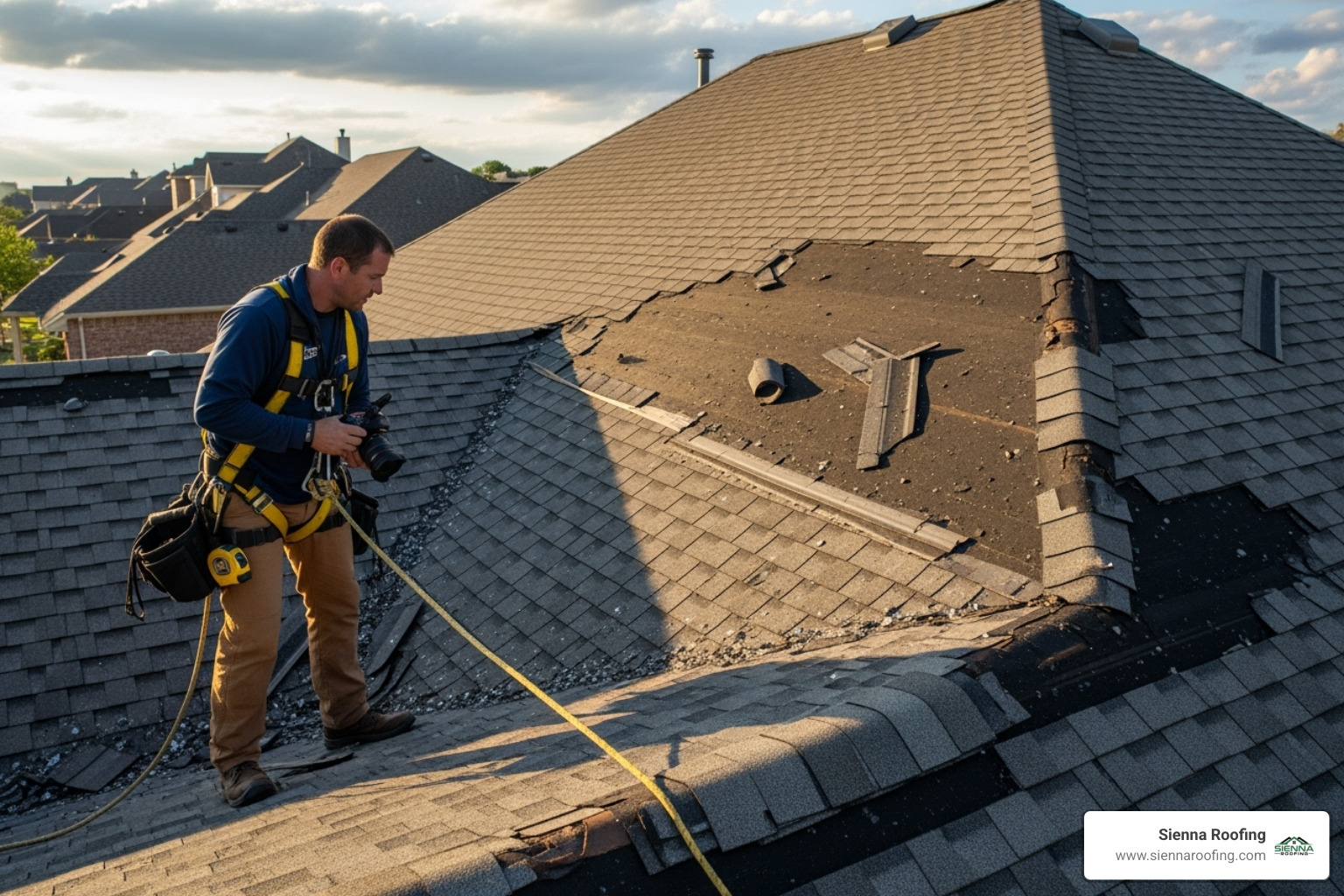
Sugar Land’s climate is a classic double-edged sword: we enjoy beautiful, mild weather for much of the year, but this is punctuated by severe weather events that can devastate roofs. Our experience shows that the vast majority of significant roof damage in our area can be traced back to these powerful storms.
- Storm Damage Specifics: As mentioned, hurricanes, hailstorms, and high winds are the primary culprits. Hail impacts can create subtle dings that are nearly invisible from the ground but have compromised the shingle’s waterproofing layer. Wind doesn’t just rip shingles off; it can lift them, breaking the sealant strip on the underside, and then lay them back down. The shingle looks fine, but it’s now a flap that allows wind-driven rain to penetrate underneath. Falling tree branches during a storm are another common cause of punctures and structural damage.
- Post-Storm Inspections: After any significant weather event, especially one involving hail or high winds, we strongly recommend a professional roof inspection. Many homeowners are shocked to learn they have substantial, insurance-claim-worthy damage that they couldn’t see from their driveway. Early detection is absolutely key to preventing a small, storm-related issue from turning into a major leak and interior damage. You can find helpful storm-preparedness information from sources like the Federal Emergency Management Agency (FEMA).
- Navigating the Insurance Claims Process: A major part of dealing with storm damage is the insurance claim. Most homeowners’ policies cover damage from sudden, unforeseen events like hail or wind (often called “Acts of God”). We have extensive experience assisting homeowners through this often-confusing process. We can provide a thorough, detailed inspection report with photographic evidence, meet with your insurance adjuster on-site to point out the damage, and ensure the scope of work they approve is accurate and sufficient to restore your roof to its pre-storm condition. For more on this, see our page on storm damage roof repair.
- Long-term Wear and Tear: Beyond the acute damage from a single storm, the cumulative effect of our climate takes its toll. The constant exposure to intense UV rays, high humidity, and wide temperature fluctuations leads to gradual wear and tear. This slow breakdown of roofing materials makes them progressively more susceptible to damage from even moderate weather events. This is precisely why a roof in the Houston area typically has a shorter lifespan, averaging 15 to 20 years, compared to roofs in more temperate climates.
Repair or Replace? Making the Right Call for Your Sugar Land Home
Standing in your driveway, staring up at a damaged roof, you’re likely facing the single most common and critical question we hear from homeowners: “Should I repair this, or is it time to replace the whole thing?” It’s a significant decision with major financial implications, and frankly, there’s no simple, one-size-fits-all answer. But don’t worry – we’re here to walk you through the key factors our experts evaluate to help you make the smartest, most cost-effective choice for your home and your budget.
The truth is, this decision hinges on a careful evaluation of a few critical factors. The age of your roof is almost always our starting point. Here in the greater Houston area, the combination of intense heat, humidity, and severe storms means most asphalt shingle roofs have a realistic lifespan of about 15 to 20 years. If your roof is approaching or has surpassed that age and you’re dealing with persistent problems, a full replacement typically offers the best long-term value and peace of mind. Constantly patching an old, failing roof can be a frustrating and ultimately more expensive endeavor. However, if you have a newer roof – say, under 15 years old – and the damage is confined to a specific area, a professional roofing repair Sugar Land is almost always the most sensible path.
The extent of the damage provides the next piece of the puzzle. We assess whether the problem is isolated or systemic. Is it a few missing shingles from a recent storm, or are we seeing widespread curling, cracking, and granule loss across multiple roof slopes? A common industry guideline is the 25-30% rule: if more than a quarter of your roof’s surface is damaged or showing signs of failure, replacement becomes the more practical and economical option. Trying to patch that much damage can lead to a messy, uneven appearance and may not effectively address underlying issues. But for smaller, localized problems, a targeted repair is the perfect solution.
Next, we conduct a cost-benefit analysis. This is where our experience provides immense value to homeowners. We’ve seen situations where a homeowner has paid for multiple small repairs over a few years, and the cumulative cost begins to approach what a new roof would have cost in the first place. We’ll always provide you with transparent, honest numbers for both repair and replacement options, allowing you to see which choice provides the best return on your investment and protects your home for the long haul.
Your future plans for the home also play a role. Are you planning to sell within the next few years? A brand-new roof can be a powerful selling point, potentially increasing your home’s curb appeal and resale value, and giving potential buyers confidence. If you’re planning to stay in your home for another decade or more, investing in a high-quality replacement can provide decades of worry-free protection. However, if you’re settled in but facing budget constraints, a quality repair might be all you need to safely defer the larger expense.
For a more in-depth look at the replacement process, check out our comprehensive guide on Replacing Your Residential Roof in Sugar Land: What You Need to Know.
When a Roof Repair is the Smart Choice
Sometimes, a full roof replacement is simply overkill, and a well-executed repair is the perfect solution. A professional repair can resolve your immediate problem, extend the life of your existing roof, and save you thousands of dollars. We take pride in helping homeowners find these smart, cost-effective solutions.
Isolated damage is the ideal scenario for a repair. Perhaps a recent hailstorm only affected one slope of your roof, or a tree limb fell and punctured a small 5×5 foot section. When the problem is clearly contained and the rest of your roof is in good health, we can perform a surgical repair, seamlessly integrating new materials to restore your roof’s integrity without disturbing the healthy sections.
Minor leaks are another prime candidate for repair. If you’re seeing a small water stain on your ceiling, it’s typically indicative of a single point of failure—like a cracked pipe boot or compromised flashing around a chimney—rather than a sign that your entire roof system is failing. Our technicians are experts at leak detection; we can trace the source of the water intrusion and perform a targeted repair to seal it up before it can cause more significant damage.
We understand that budget constraints are a reality for many families. A full roof replacement is a major investment, and it’s not always feasible at a moment’s notice. A high-quality, professional repair can be an excellent strategy to buy you valuable time, keeping your home safe and dry until you are financially ready to undertake the larger project. There is no shame in taking the prudent repair route when it makes the most financial sense for your family.
For roofs that are under 15 years old, repair is almost always our first recommendation, provided the damage isn’t catastrophic. A younger roof still has plenty of serviceable life left in it. Addressing specific issues like lost shingles or minor flashing problems now will help ensure it reaches its full potential lifespan, maximizing your initial investment.
If you’re dealing with shingle-specific issues, our guide on Roof Shingle Repair Near Me: Fix Your Roof Without Losing Your Mind can provide more detailed options.
Materials Built to Last in the Texas Climate
When selecting roofing materials that can withstand Sugar Land’s intense weather, you need options that won’t surrender to scorching heat, torrential rain, or surprise hailstorms. We have extensive experience with all major roofing materials, and each has its own set of advantages depending on your home’s style, your budget, and your long-term goals.
Asphalt Shingles: These remain the most popular choice in North America, and for good reason. They offer a fantastic blend of performance, durability, and affordability. In our climate, a properly installed architectural shingle roof will typically last 15-25 years. Modern architectural (or dimensional) shingles are thicker and more durable than older 3-tab styles, offering better wind resistance and a more attractive, textured look. Many manufacturers now offer Class 4 impact-resistant shingles, which are specifically designed to better withstand hail, potentially earning you a discount on your homeowner’s insurance premium. For more technical details on this material, you can visit the Asphalt Roofing Manufacturers Association.
Metal Roofing: Once relegated to barns and commercial buildings, metal roofing is now one of the fastest-growing sectors in residential roofing, and we understand why. It offers exceptional durability, with lifespans often reaching 40-70 years or more. It performs exceptionally well against high winds and hail. The most popular style, standing seam metal, has concealed fasteners that protect against leaks. Furthermore, metal is highly energy-efficient. Its reflective surface can bounce solar radiant heat away from your home, significantly reducing your cooling costs during our brutal Texas summers. While the upfront cost is higher than asphalt, the longevity and energy savings often make it a wise long-term investment.
Tile Roofing: Tile brings unparalleled beauty, elegance, and performance to a home. Whether you choose traditional clay or modern concrete tiles, you’re investing in a roof that can last 50 years or more. Tiles are impervious to rot and insect damage and offer excellent fire resistance. Their mass and vented installation method provide outstanding heat resistance, making them one of the most energy-efficient roofing systems available. The installation cost is on the higher end, and it’s crucial to ensure your home’s structure can support the additional weight, but for homeowners seeking maximum longevity and a premium aesthetic, tile is an excellent choice.
Composite Shingles: A growing category in roofing, composite (or synthetic) shingles are engineered to mimic the look of natural materials like slate or wood shakes without the associated maintenance or cost. Made from a blend of plastics and recycled materials, they are incredibly durable, often carrying Class 4 impact ratings and Class A fire ratings. They are lightweight, long-lasting (often with 50-year warranties), and offer a high-end look that can dramatically enhance your home’s curb appeal. They represent a fantastic middle ground between the affordability of asphalt and the premium performance of tile or slate.
